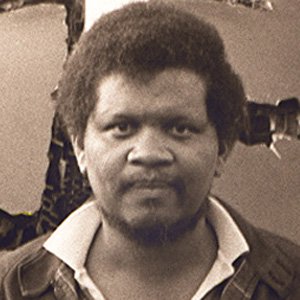
‘Called “a great writer” by none other than James Baldwin, Ishmael Reed’s reputation always had to contend with accusations of misogyny and with the barriers that a career of writing difficult-to-place novels involves. His writing, in all his books, straddled the divide between the experimental and postmodern fiction of Burroughs, Coover and Pynchon, and the strong political convictions and concerns of Ellison, Baldwin and Morrison. Between Coover and Morrison, there never was any real room for a writer like Reed, although his talent, his gift for writing is beyond any doubt. Reed is a black writer who does not cozy up to the expectations of topics or treatment of these same topics. His acidic style eats into both white and black narratives. There are various ways this works out in his work, but in his debut novel, The Free-Lance Pallbearers, published in 1967, he strikes all these chords, in a simple, almost crude way. He juxtaposes images, caricatures, quotes and screams of pain in one flame-hot bugger of a novel, which is far from flawless, but it is its numerous strengths that keep Reed’s boat afloat here.
‘And what a boat this is. On finishing the book, you will be both exhilarated and confused. Exhilarated because it’s a grand trip, calling up literary, cultural and political references with a surprising ease, dispatching real-life politicians and writers, as well as the debris of a whole culture in quick, tossed-off surreal snapshots of an inner-city waste land. The book sings, screams and hums with voices, music and noises, and moves from one sketched, unstable location to another. It demands your full attention, and it sets your brain in motion, constantly. This, however, especially the instability of its places and characters, leads to a good deal of confusion. There is nothing that interests Reed less than providing a realistic setting, realistic characters, living an unexamined life chartered by conventions. In his attempts to break free of these shackles, however, he has in his first novel thrown the reader into a largely unstructured sea of signs and symbols without giving him any kind of dry land to stand on.
‘The Free-Lance Pallbearers is the work of a jittery writer, one who burns with ideas and this book is a kind of explosion of those ideas. The plot is clearly a parody of the established plots of well-received black fiction, like Ellison’s searing Invisible Man, Wright’s Native Son or even some books by Baldwin, and it’s generous with criticism of different kinds of narratives, but it doesn’t offer a counter narrative, which has the effect of setting the reader adrift in Reed’s thoughts and obsessions. At the same time, we, the reader, are not allowed to seek dry land outside of the novel, reading it dispassionately, drawing up schemes and lists, foot- and endnoting it all. If we do that, we lose much of the intended impact of the book.
‘It is meant to confuse the reader, it is meant to confront him with his reading habits, with his easy expectations of what a ‘black novel’ could or should be. It’s confrontational, which we see right at the beginning, in the very first paragraph which gives us an idea of the novel to come: “I live in HARRY SAM. HARRY SAM is something else. A big not-to-be-believed out-of-sight, sometimes referred to as O-BOP-SHE-BANG or KLANG-A-LANG-A-DING-DONG. SAM has not been seen since the day thirty years ago when he disappeared into the John with a weird ravaging illness.”
‘These lines are spoken by the novel’s protagonist, Bukka Doopeyduk, who narrates the whole book until its bitter end. He lives in a country that is named after its fat white dictator Harry Sam, who refers to his own country as “ME”. Harry Sam resides on a toilet, and the state of his bowels, the consistency of his excrement, and the quality of the sewage water below him are constantly debated in the book, they are a matter of political faith, and careers, lives even, depend on the correct replies to the political catechism active in Harry Sam (the country). I never claimed that Reed’s criticism was subtle, it mostly isn’t, especially not with regard to politics. Overt recreations of political actions, debates, “SHE-GOAT-SHE-ATE-SHUNS”, are among the least subtly satirized targets, but they are also mostly a smoke-screen for the other targets and re-enactments.
‘Like many writers of his time, Reed seeks to locate the political in the private and expose the workings of the former by scrutinizing the structure and functions of the latter. He does not, however, try to imagine a ‘normal’ household and use the resulting images and situations as a source. Instead he staggers, no, he jumps ahead, and projects parts of everyday life onto the grotesque canvas of politics, showing one within the framework of the other, but both seen very clearly. And vice versa: what, in The Free-Lance Pallbearers, remains of regular relationships, is blown up with Reed’s satiric lens and corroded by his political thinking. It is this aspect of his work that has earned him the accusations of misogyny, because his invariably male protagonists find in relationships, especially in marriage, the mark of repression, the yoke of societal control.
‘Bukka’s language, and beliefs and what these things say about Bukka’s relationship to his fellow black men, and about The Free-Lance Pallbearers‘ relationship to other novels dealing with ‘the black experience’. Reed purposefully eschews clever writing, or rather: writing that’s clever for the sake of being clever. Reed published this novel the same year that Pynchon published his Crying of Lot 49, which is a nice little tale, but considerably less well realized than all his other books. Interestingly, it’s major flaw, i.e. the bland, and obvious sequence of symbols, of allegories and tropes, is one of Reed’s main objects of ridicule, while at the same time they both make heavy use of some very similar tropes, symbols or images, for example waste, garbage, excrement.
‘The difference is that in Pynchon, it is a trope, one symbol in a series of them, one allusion of many, whereas Reed, as I just explained, uses it as a direct mirroring of real excrement, real shitting, one of the most private acts of them all, an act that even some married couples hide from each other. All this has an additional metaphorical layer, but it works first and foremost on a direct, almost literal level. His confrontations rely on the brute impact of his caricatures and parodies, not on an intellectual analysis of its symbolic structure. At the end of his book, no dog hangs from meat-hooks, it’s a human being, visited by his parents who demand to given their due. Bukka, as a character, is the only one who doesn’t fit all that; he’s clearly artificial, a literary ghost, a black Candide “cakewalking” through this waste land.
‘In Bukka, Reed has created a character that is both a reflection of the books, culture and society criticized, as well as the means to criticize them. Just as the book as a whole can be read as a send-up of the traditional black novel, the awakening of a black man to the social and political reality around him, the state he is in and the society that is the reason for this state, so Bukka Doopeyduk is Reed’s send-up of the idealized black protagonist, and of the clever, fashionable black writer at the same time. Parts Candide, parts Malcolm X (including, I think, direct quotes from the Autobiography), Bukka isn’t like Wright’s Bigger, because he is more than that, he’s Wright, so to say, himself. Bukka is the narrator of the book, but his language differs strongly from the language of everyone else in the book and he’s accordingly being made fun of. Bukka is straining to speak ‘proper’ English, full, well-turned sentences, devoid of dialects or sloppiness. He does not, of course, succeed, at least not completely; we notice this partly through a slightly deviant grammar, and partly through orthographical errors.
‘It is the latter that create the most direct link to the writers made fun of, since these mistakes are often silent ones, mistakes of writing, not of speaking. Bukka the writer is sometimes, fascinatingly, at variance with Bukka the protagonist. While Bukka the writer is in control of everything, since he tells it all, Bukka the protagonist is frequently silenced, even made to mouth speeches that he didn’t write and wouldn’t approve of. Bukka the writer wants to be clever but what he mainly does is suck up to the structure that is currently governed by Harry Sam. It is his distaste that we find in the depiction of homosexuality, of women, even of Bukka Doopeyduk himself. Indeed one could say that Bukka is betrayed by the narrator, in effect by himself. This is an ingenious mirroring of another kind of betrayal in the book, that of Bukka by some of his fellow black men, who have entered into “SHE-GOAT-SHE-ATE-SHUNS” with Harry Sam (the person) and give up their brother at the drop of a dime.
‘This is maybe Reed’s most powerful criticism, and his most well made point: how control is not just control of the body with punishment à la Surveillir et Punir, but how it’s also control of one’s own narrative, and how that isn’t a “choice” that we consciously make, but that that’s a narrative that’s written by a different writer, like us, but unlike us (to mangle a line by Wallace Stevens). Bukka is trying to order, to give shape to the life he encounters, but he, like the reader, is swept away by the waves of ideas that Reed blasts at us. There is no life except in a distanced, processed way here, but the tumble and chaos of Harry Sam (the country) could be a better attempt at conveying the exigencies, the contradictions and the cultural problems of that life.’ — shigekuni
____
Further
Ishmael Reed Official Website
Ishmael Reed @ Wikipedia
‘About Ishmael Reed’s Life and Work’
Konch Magazine
‘Self-Reflexivity and Historical Revisionism in Ishmael Reed’s Neo-Hoodoo Aesthetics’
‘Trouble Beside the Bay’, by Ishmael Reed
‘AT WORK: Ishmael Reed on ‘Juice!’’
‘Media Diet: Ishmael Reed’
‘Ishmael Reed on the Life and Death of Amiri Baraka’
‘The Dark Heathenism of the American Novelist Ishmael Reed’
‘Ishmael Reed Gets in the Ring’
‘Ishmael Reed: “All the Demons Of American Racism Are Rising From the Sewer”
‘Ishmael Reed’s Musical Career’
‘Neo-HooDoo: The Experimental Fiction of Ishmael Reed’
Greil Marcus on Ishmael Reed’s ‘Flight to Canada’
‘The Critical Reception of Ishmael Reed’
‘ e political conspiracies of Ishmael Reed’s Mumbo Jumbo’
Ishmael Reed’s Top 10 Favorite Books
‘Ishmael Reed on the Language of Huck Finn’
Buy ‘The Free-Lance Pallbearers’
___
Extras
Meet Ishmael Reed
Ishmael Reed reads, 1993
To Become A Writer, Ishmael Reed
Ishmael Reed on Washington, Jefferson, and Lincoln
Ishmael Reed: The Complete Muhammad Ali
____
Interview
from The Review of Contemporary Fiction

REGINALD MARTIN: Camus wrote in “Neither Victims nor Executioners” that the only really committed artist is he who, without refusing to take part in the combat, at least refuses to join the regular armies and remains a freelance. In many respects, I see you that way, but many of your critics, Houston Baker, Jr., and Addison Gayle, Jr., for example, seem to throw out any possibility that issues they support may also be issues that you equally support.
ISHMAEL REED: I saw Houston Baker, Jr., recently in Los Angeles. I don’t bear any ill feelings toward him. In fact, he was very cordial toward me. I feel that the piece published in “Black American Literature Forum” that was edited by Joel Weixlmann was irresponsible, and my point is that they would never attack white writers the way they do black writers in that magazine, and I still maintain that. All these scurrilous charges that Baraka made against black writers—and I’ve discussed this with Baraka—those charges were outrageous—he called them traitors, capitulationists.
RM: Did you see Baraka’s recent piece on PBS in which was outlined his recent battles with police, where they accused him of beating his wife in his car, when they were just having a domestic argument, disagreement—
IR: That kind of thing happens to black people every day in this country, and they don’t receive that kind of sentence he did, which was to go to prison on the weekends; I think he lectured there—an outside lecturer.
RM: What did Norman Mailer receive for stabbing his wife with a pen knife?
IR: Well, they all like that, they all love that kind of stuff in New York. This Son-of-Sam syndrome, where, I guess, this comes from an interest in Russian psychology, Russian literature, this Raskolnikov notion, that there are some people superior to other people, that Dostoyevsky trip, you know, and that these people are above the kind of rules that apply to you and me. And I think that people who indulge in bizarre behavior are existential heroes, like Jack Abbott, Gilmore, I think even Baraka had that kind of role in cultural hero. As a matter of fact, there was someone in France recently, and the Mitterand government intervened to get him out of jail, a poet, or so he called himself a poet, and he went out and robbed a bank again or something. I don’t know, there’s this fascination with this kind of character. And I feel that that is just a kind of an Eastern, Manhattan, intellectual obsession.
RM: It seems to me that black writers have to be marketed into neat little categories to sell books, and if you’re not able to fit into any of these slots, then you have a problem.
IR: Well, yes, that’s true. That’s definitely true.
RM: You mention in your interview with “Conversations” that certain people were in the right place at the right time and/or they were also “chosen” in the 1960s. Whites said to these people, “Here, we don’t understand this literature so you guys tell us how to understand it and you guys handle the boat as far as black literature is concerned—”
IR: I think there was a nonaggression pact signed between the traditional liberal critics and the black aesthetic critics. They were brought into the publishing companies about the same time that I was, about the same time that Doubleday—Doubleday didn’t renew my contract and this was about a week after I had been nominated for two National Book Awards, and then later I learned how these black aesthetic people had gone on. . . and I wasn’t the only victim—
RM: Those nominations would be for-
IR: Doubleday published Free-Lance Pallbearers and Yellow Back Radio Broke Down, for which I just got my royalty check beyond advance last summer.
RM: That was some years ago—
IR: Those books are still in print, all the books I’ve written are still in print, but I heard that other people had been victimized also. Cecil Brown, for example, who published Life and Loves of Mr. Jiveass Nigger—he’s got a new book out called Days Without Weather, which hasn’t received a single review anywhere, well very few, except for the one in the “New York Times” by David Bradley, and I think that’s it. But the black aesthetic crowd came in and writers were required to perform their Marxist blueprints. But that’s happened to Afro-American artists throughout history.
RM: And if you didn’t conform to the blueprints?
IR: Well, what we’re trying to do is—the people who made people like Ellison and Saul Bellow and Alfred Kazin and Baldwin, Norman Podhoretz and those kind of people, don’t have the power they used to have. And this is the reason for this kind of hysteria that, I believe, we have happening now. . . that the Afro-American writers seem pretty much dispersed, so that in any region in the country you might find writers, where before you wouldn’t, where before you would find these writers clustered around Manhattan; now it’s all over. And so the people who traditionally had control over Afro-American literature—which meant a lot of things, it meant hard cash for example; if I persuade you that I know something about Afro-American literature and I’m not black, well, that’s a very lucrative enterprise. I’m finding that the harshest criticism I’m receiving these days is from left-wing people who have convinced magazine editors and newspaper editors that they know something about black literature—they’re not black, but they see what I’m doing and what some of my colleagues are doing as a threat to this little hustle they had—a moonlighting hustle.
RM: You mean these people who go off to magazines and newspapers, and—
IR: Well, Robert Towers of the “New York Review of Books” wrote a review of my book and Alice Walker’s book in the same column and said that Alice Walker was the best practitioner of black English that had ever written. I challenged that and said that he hadn’t read much. I mean, how can you make that superlative statement? And he admitted he hadn’t read much. How can you make a statement like that when you haven’t examined the field? And then finally I said that he hadn’t read Ernest Gaines and Margaret Walker, and in the final exchange we had—we had this exchange in a series of letters—he said they were obscure writers. You know, here’s Ernest Gaines who wrote “Miss Jane Pittman,” which is probably playing somewhere right now in the country on television. What we’ve done by removing the scene from Manhattan—though we have an office in Manhattan, the main publishing office—what we’ve done is publish writers from all over the country, and we have challenged the traditional influence that the liberal community has had over Afro-American writing. And I think that this is the reason that Baraka has come forth, because Baraka has made up with them, and he’s the one who is saying all these things about Afro-American writing, that it’s not up to par and all this kind of thing.
RM: When I was younger, I was so fascinated that blacks were writing anything that I didn’t notice until later that the bent of writing seemed to shift in the direction of the economic climate of the country at the moment. The writing clubs would shift with the times. For example, we now have Alice Walker winning the Pulitzer—
IR:Well, I think that Alice Walker and some of the other women. . . there’s just a few of these black feminist writers who are playing this “hate black male” angle. Bill Cook, a friend of mine at Dartmouth, said that this “rape romance” was actually introduced by female writers in the nineteenth century. There are several books that have been written about this—there was this fascination by Anglo women for Afro-American males when there were none around . . . I’m thinking of Salem, Massachusetts, where I think there was only one black person in town, where these woman had hallucinated about black male lovers. So I think people like Alice Walker and those kinds of feminist writers who are supported by people like Gloria Steinem—you see how this patronage continues.
RM: That was last summer in “Ms.”—
IR: She has a new thing in which she said all those awful things about black male writers married to white women, John A. Williams, Baraka . . . awful things.
RM: Somewhat like that guy you worked with who said of your writing that it wasn’t quite civilized, you weren’t really black, because you were married to a white woman—
IR: Well, I feel I really paid too much attention to that whole thing. That was a case of overkill on my part, to even respond to anything like that. Anyway, these black feminists have very cleverly played to the . . . I think this has something to do with the economic situation in the country also; black males have always been the scapegoats. I’m sure that you could go back and make a graph showing that all the killings of black males increased in times of economic difficulty. As a matter of fact, a black man was lynched last year. He was killed first, then hanged from a tree. And so I think that some black feminists are taking advantage of this, so I call these black feminists, people like Alice Walker, the kind of novels they write, I call them “neoconfederate” novelists, the kind of writing that Thomas Dixon wrote in The Clansman. This kind of plantation literature, they’re just reviving these notions, whipping up hysteria, and they’re supported by people like Gloria Steinem—Susan Brown Miller was a judge on the committee which gave Alice Walker the American Book Award, and this was her reward for being the intellectual midwife of Susan Brown Miller’s terrible and really fallacious ideas about black men.
RM: Addison Gayle, Jr., speaks critically about your perception of the relations between black men and women when he reviews Flight to Canada in relation to Eva’s Man by Gayl Jones. He writes: “Reed, of course, is an anomaly, and if much of his fiction, Louisiana Red and Flight to Canada, proves anything, it is that black women have no monopoly on demons, real or imaginative. These two novels demonstrate that, like the ‘buyer’ in Caracas, like blacks in general, male and female, the web of folklore which has circumscribed much of our relations with each other from the days of slavery to the present time, have been impervious to the best efforts of conscientious men and women to tear it down. Thus, Reed’s central argument, as developed in both Louisiana Red and Flight to Canada, may be summed up thusly: since the days of slavery, collusion between black women and white men has existed in America. The major objective of this collusion has been the castrating of black males and the thwarting of manful rebellion.”
IR: Well, I think that anybody who reads that ought to go and read his autobiography, The Wayward Child, and pick up on some of his notions on black women and white women. As I said in a letter to “Nation” magazine recently, women in general make out better in my books than black men do in the works of black women and white women, feminist writers. And I gave the example of Gayl Jones’s Eva’s Man—not to mention Corregidora—in which black men are portrayed as brutes, apes, but also Toni Morrison’s Sula, in which the character Jude is burned alive by his mother, something I had heard of in black culture. And Alice Walker’s fascination with incest—which can always get you over, if you have the hint of incest. I mean, it got Ellison over; there are a lot of male critics who are interested in that, who are interested in black male sexual behavior—they’re fascinated. There was recently a review on Louis Harlan’s book on Booker T. Washington, by Malcolm Boyd—he used to be a hippie preacher or something; I don’t know what he’s doing now. And he spent a whole lot of the book—he spent the whole article on this story about Booker T. Washington being caned for knocking on a white woman’s door or something like that. Of all the things Booker T. Washington had done! This man was just fascinated with this. He spent three or four paragraphs talking just about that! So there’s an obvious fascination with incest and rape, and Alice Walker picks up on things like this. I tried to get my letter published in “Nation” magazine. I finally had to go to the American Civil Liberties Union here in northern California to get my reply published to what I considered to be a hatchet job done by Stanley Crouch. He had all the facts about my career and publishing activities wrong. They see Al Young and myself as leaders of some multicultural revolt threatening the things they’re doing—against their interests. But in “Nation” I wrote that the same charges that Alice Walker makes against black men were made about the Jews in Germany. I guess we don’t have a large organization like the Anti-Defamation League or a large pressure group or lobby—
RM: And remember it is a black criticizing another black, so others may not be interested.
IR: Well, when Hannah Arendt criticized the Jewish people for collaborating with the Nazis, saying that American Jews could have saved two-thirds of the victims if they had cared about them, there was a controversy. But when you look at the Pulitzer Prize committee, there’s a president from Dow Jones on it, and mostly white males—and on the American Book Awards, which we began out here, there’s still a dispute; we began the American Book Awards out here, and our American Book Awards are really more representative of what’s happening in American literature than theirs—but knowing these things, you can see the motivation behind some people making the black male into a pariah. I think that Addison Gayle hasn’t read my books carefully because he doesn’t consider that there are all kinds of women in my books; and although I may exaggerate, I mean use hyperbole, those people are real, they exist. And if you go out to the grass roots where I stay, I think those people will tell you that those characters exist.
RM: Well, satire is usually based on real types.
IR: Sure, surely it is. I think that was written early before Gayle made his confession in this remarkable book, The Wayward Child, in which he repudiates the black aesthetic, says he was put up to it. Just as Baraka said he was put up to anti-Semitism. Yeah, they all said that people like David Lorentz put them up to it. And David Lorentz is not here to say anything different. And Baraka said that nationalists and Muslims around him put him up to anti-Semitism. So all those people are backing out of their former positions. So I feel that if you asked Addison Gayle about this now, he’d probably say something different.
RM: Well, that’s what I was trying to get at earlier, that as the marketplace changes—
IR: Yeah, some of these people are opportunists—going for the cash and notoriety.
RM: Then it goes without saying that these people—not just the black critics but all critics—invent things that they say make up the black aesthetic, in fact that becomes a limiting label.
IR: They haven’t investigated Afro-American folklore, nor have they investigated voodoo. I call it Neo-HooDooism. So there’s a reference that goes back to shed light on the aesthetic I’m working out, which I consider to be the true Afro-American aesthetic. When I say Afro-American aesthetic, I’m not just talking about us, you know, I’m talking about the Americas. People in the Latin countries read my books because they share the same international aesthetic that I’m into and have been into for a long time. And it’s multicultural. The West’s Afro-American aesthetic is multicultural—it’s not black. That’s what they don’t understand. This black aesthetic thing is a northern, urban, academic movement—that’s why you have a fancy word like “aesthetic”, which nobody figures out. When you come to talk about standards of taste, everyone differs. It’s a vague enough word so that they can get away with it. And even though they try to make it sound like it’s really important—that’s the black intellectual pastime—discussing all these phantoms and things. You look at all these conferences for a hundred years, same questions.
RM: And probably the same type of people serving on the panels?
IR: Oh sure.
__
Book
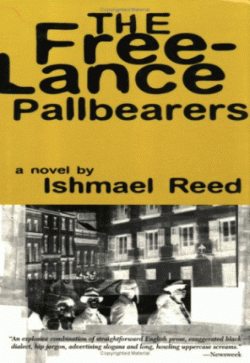 Ishmael Reed The Free-Lance Pallbearers
Ishmael Reed The Free-Lance Pallbearers
Dalkey Archive
‘Ishmael Reed’s electrifying first novel zooms readers off to the crazy, ominous kingdom of HARRY SAM a miserable and dangerous place ruled for thirty years by Harry Sam, a former used car salesman who wields his power from his bathroom throne. In a land of a thousand contradictions peopled by cops and beatniks, black nationalists and white liberals, the crusading Bukka Doopeyduk leads a rebellion against the corrupt Sam in a wildly uproarious and scathing satire, earning the author the right to be dubbed the brightest contributor to American satire since Mark Twain. — The Nation
‘Reed’s gift is for the outrageous, for giving vivid expression to cultural controversies very much in the air. . . . He is one of the most underrated writers in America. Certainly no other contemporary black writer, male or female, has used language and beliefs of folk culture so imaginatively, and few have been so stinging about the absurdity of American racism.’ — New York Review of Books
____
Excerpt
Da Hoodoo Is Put on Bukka Doopeyduk
I live in HARRY SAM. HARRY SAM is something else. A big not-to-be-believed out-of-sight, sometimes referred to as O-BOP-SHE-BANG or KLANG-A-LANG-A-DINGDONG. SAM has not been seen since the day thirty years ago when he disappeared into the John with a weird ravaging illness.
The John is located within an immense motel which stands on Sam’s Island just off HARRY SAM.
A self-made Pole and former used-car salesman, SAM’s father was busted for injecting hypos into the underbellies of bantam roosters. The ol man rigged many an underground cockfight.
SAM’s mother was a low-down, filthy hobo infected with hoof-and-mouth disease. A five-o’clock-shadowed junkie who died of diphtheria and an overdose of phenobarb. Laid out dead in an abandoned alley in thirty-degree-below snow. An evil lean snake with blue, blue lips and white tonsils. Dead as a doornail she died, mean and hard; cussing out her connection until the last yellow flame wisped from her wretched mouth.
But SAM’s mother taught him everything he knows.
“Looka heah, SAM,” his mother said before they lifted her into the basket and pulled the sheet over her empty pupils. “It’s a cruel, cruel world and you gots to be swift. Your father is a big fat stupid kabalsa who is doin’ one to five in Sing Sing forfoolin’ around with them blasted chickens. That is definitely not what’s happening. If it hadn’t been for those little pills, I would have gone out of my rat mind a long time ago. I have paid a lot of dues, son, and now I’m gonna pop off. But before I croak, I want to give you a little advice.
“Always be at the top of the heap. If you can’t whup um with your fists, keek um. If you can’t keek um, butt um. If you can’t butt um, bite um and if you can’t bite um, then gum the mothafukas to death. And one more thing, son,” this purple-tongued gypsy said, taking a last swig of sterno and wiping her lips with a ragged sleeve. “Think twice before you speak ’cause the graveyard is full of peoples what talks too much.”
SAM never forgot the advice of this woman whose face looked like five miles of unpaved road. He became top dog in the Harry Sam Motel and master of HIMSELF which he sees through binoculars each day across the bay. Visitors to his sprawling motel whisper of long twisting corridors and passageways descending to the very bowels of the earth.
High-pitched screams and cries going up-tempo are heard in the night. Going on until the wee wee hours of the morning when everything is OUT-OF-SIGHT. Going on until dirty-oranged dawn when the bootlegged roosters crow. Helicopters spin above the motel like clattering bugs as they inspect the constant stream of limousines moving to and fro, moving on up to the top of the mountain and discharging judges, generals, the Chiefs of Screws, and Nazarene Bishops. (The Nazarene Bishops are a bunch of drop-dead egalitarians crying into their billfolds, “We must love one another or die.”)
These luminaries are followed by muscle-bound and swaggering attendants carrying hand-shaped bottles of colognes, mouthwash and enema solutions-hooded men with slits for eyes moving their shoulders in a seesaw fashion as they carry trays and towels and boxes of pink tissues—evil-smelling bodyguards who stagger and sway behind the celebrated waddle of penguins in their evening clothes.
At the foot of this anfractuous path which leads to the summit of Sam’s Island lies the incredible Black Bay. Couched in the embankment are four statues of RUTHERFORD BIRCHARD HAYES. White papers, busted microphones and other wastes leak from the lips of this bearded bedrock and end up in the bay fouling it so that no swimmer has ever emerged from its waters alive. Beneath the surface of this dreadful pool is a subterranean side show replete with freakish fish, clutchy and extrasensory plants. (And believe you me, dem plants is hongry. Eat anything dey kin wrap dey stems around!!)
On the banks of HARRY SAM is a park. There the old men ball their fists and say paradoxes. They blow their noses with flags and kiss dead newsreels. Legend has it that when the fateful swimmer makes it from Sam’s Island to HARRY SAM, these same old men will sneeze, swoop up their skiffles and rickety sticks, then lickety-split to rooms of widow executioners in black sneakers. It is at this time that the Free-Lance Pallbearers win take SAM.
I stood outside my dean’s office at the Harry Sam College. I had flunked just about everything and had decided to call it quits and marry a chick I’d been shackin’ up with for a few years. I would provide for her from earnings received from working at a hospital as an orderly and where I had been promoted frequently. (“Make-um-shit Doopeyduk,” the admiring orderlies had nicknamed me.) U2 Polyglot, the dean, had been very nice to me so that I couldn’t conceive of leaving the hallowed halls of Harry Sam without saying good-bye to him. Just as I opened the door to his office, a sharp object struck me in dead center of the forehead. It was a paper airplane which received its doom at the tip of my toes.
“O, forgive me,” U2 said. “Are you hurt? Have a Bromo Seltzer,” the dumpy redheaded man in clumsy tweeds and thick glasses fizzed.
“It’s an right, U2 Polyglot. I just stopped by to tell you that I was leaving school.”
“Leaving school? Why how can that be, Bukka?” (My name is Bukka Doopeyduk.) “You’re one of the best Nazarene apprentices here. Why, you’re on your way to becoming the first bacteriological warfare expert of the colored race.”
“I know that and I appreciate everything you’ve done for me but I am flunking just about everything and plus I’m kinda restless. I want to get married and see what’s out in the world. Got to go, Polyglot.”
“Well, on the other hand, maybe dropping out and tuning in will turn you on, Bukka. Who knows? But whatever you decide, I wish you a lot of luck and I’m sure that we’ll be running into each other from time to time.”
U2 and I shook hands and I left him to a paper he was preparing for an English literary quarterly, entitled: “The Egyptian Dung Beetle in Kafka’s `Metamorphosis.”‘ He had dropped to his knees and begun to push a light ball of excrement about the room by the tip of his nose. He wanted to add an element of experience to his paper. You know, give it a little zip.
That night I called Fannie Mae’s home to find out if she had made the final preparations for the wedding which would take place in the parish office of Rev. Eclair Porkchop, head of the Church of the Holy Mouth. A shrill tales-of-the-crypt voice answered the phone.
“May I speak to Fannie Mae?”
“She not home.”
“What time will she be in?”
“No tellin’ what time she be in. Is dis you, Bukka Doopeyduk, the boy what’s gone marry my granchile?”
“That’s me.”
“Well, I don’t have to tell you how fast dese youngins is today. She probably out whipping dope needles into her mouf or somethin’ lak dat.”
“When she returns, would you tell her that the wedding ceremony will take place tomorrow afternoon and shortly before I must present my application to the Harry Sam Housing Projects and—”
“Hold on, Dippydick. Dis ain’t no IBM factory. I’m scribbling with a chewed-up pencil and considering the fact dat I’m a spindly ol woman with two bricks for breasts, it’s awful admirable dat I’m even able to take my conjur lessons through the mail under the Mojo Retraining Act. So take it from the top and go real slow.”
I repeated the instructions.
“Okay. I’ll tell her Daffydink Dankeydim Doopeydank …”
“Doopeyduk.”
“Whatever your name is, listen here. If you don’t take good care of my granchile, I’m gonna put da hoodoo on you, and another thing …”
“What’s that, ma’m?”
“Don’t choo evah be callin’ here at twelve o’clock when I’m puttin’ da wolfbane on da do.”
(CLICK!) She shut the phone down so hard my ears were seared. Well, that’s show biz, Bukka Doopeyduk, I sighed, cakewalking my way back to the limbo of a furnished room.
We Would Need a Bigger Place
I picked up the booklet from the table in the housing project office. Above the table hung an oil portrait of SAM in a characteristic pose: zipping up the fly of butterfly-embroidered B.V.D.’s and wiping chili pepper sauce from his lips.
Next to the painting hung some employment ads:
“Passive sleep-in maid wanted.” “Apple-pickers 50¢ an hour. Must like discipline.”
The cover of the booklet showed the housing manager holding the keys to an apartment. Color them gold. He smiles as he points to the Harry Sam Projects with the pose of an angel showing some looneybeard the paradise. On the next page, the typical family scene. Dad reading the papers, pipe in mouth. The little child seated on the floor busily derailing choo-choo trains, while with goo-goo eyes and smiles shaped like half-moons, the appliances operate these five rooms of enveloping bliss. And after a long list of regulations a picture of the park area. All the little children having a ball. Fountains, baby carriages and waxen men tipping their hats to waxen women.
I sat in the section where the applicants were biding their time until a woman with a sweater draped over her shoulders called their names. They were interviewed by a roly-poly man in 90 per cent rayon Sears and Roebuck pants, mod tie and nineteen-cent ban-point pen sticking from the pocket of his short-sleeve shirt, and hush puppy shoes. (No shit. Da kat must have been pushing forty and he wore hush puppy shoes and a polka-dot mod tie. Why da man looked ridiculous!)
Some of the women had electronic devices plugged into their ears. They listened to the hunchbacked housewives phone in their hernias to the bugged benzedrined eyes who negotiated toy talk for a living.
Typical: “Hello Frank? Dis Frank? Been trying to get ya ever since you come on da air. Geez kids, it’s Frank. Come and say hello to ya Uncle Frank. Hiya Frank. We sure like to hear toy talk out here in Queens and Brooklyn, which brings me to the point about what I wrung ya up. You see we tink dey got too much already, running around in da streets like monkies. Why can’t dey behave demselves like da res of us ‘mericans. And as far as bussing wit um goes—we don’t rink it’ul ‘mount to much for da very simple reason dat we don’t tink it’s too good. Dey should help demselves like we did when we come over on da manure dumps. Take my ol man for an instant. Worked hisself up and now he is a Screw. Killed fourteen hoods last week what was comin’ at um wit a knife. And my son jess shipped overseas to put down dem Yam riots what’s gettin’ ready to break loose. As you can see we are all doin’ our part. Why can’t dey?”
But occasionally this informative chitchat would be interrupted by a bulletin from radio UH-O:
UH-OOOOOOOOOOOOOOOOOOOOOOOOOOOOOO
DEM CHINAMENS DONE GALLOPED INTO THE SUBURBS ON WEREWOLF SANDALS/KIDNAPING HEEL-KICKING HOUSEWIVES HANGING OUT DA WASH/BREAKING TV ANTENNAS OVER DERE KNEES DEY WAYLAID COMMUTER TRAINS AND SMASHED INK INTO THE FACES OF THE RIDERS WHO DOVE INTO THE HUDSON TRYING TO ESCAPE/
TONS OF CREDIT CARDS SALVAGED/BULLETPROOF RICKSHAWS SPOTTED IN NEW ROCHELLE/ (AND SOME SINISTER-LOOKING JUNKS DONE SNEAKED INTO DA EAST RIVER TOO!) MAJOR CRISIS SHAPING UP/SAM TO DRESS HIMSELF AS SOON AS MAKEUP MAN ARRIVES AND THE URINALS ARE SCRUBBED.
Conorad: YAWL BETTER RUN!
“Bukka Doopeyduk,” the social worker announced through his Rudy Vallee megaphone. Sitting down he officiously pinched his hooked nose.
On the desk were two round faces. One larger than the other. Smiling. Wife and girl child. In a box a row of half-chewed maraschino cherries resting in their wrappers. Gold trimmings on a get-well card which read: “We all miss you in unit X”—followed by a list of stingy. signatures. The Nazarene priest lifted his chubby face from the sheaf of papers he held in his hands. Rubbing his palms together he talked.
“Sorry I kept you waitin’ so long, chum, but me and da missus were up late last night. Caught dat Sammy out at Forest Hills. Boy dat Sammy sure can blow the licoric stick and tickle da ivory. He was better ‘n da time we caught him at da Eleanor Roosevelt birthday celebration. He was twirling his cane and kicking up wit da spats when suddenly a miracle happened. A helicopter landed right on da stage and out came da savior and hope of da world. He put his arm around Sammy and said, `Sammy is my ace boon koon so you guys treatum real good. Unnerstand?’ Well, after dat somethin’ happened dat’ll just get you in da girth, I mean gird you in da pith, I mean dere was a dearth of boos and nothin’ but stormy applause after an especially pithy ditty SAM done about how hard it was when he was back in rat pack p.s. Why pennies run outta da sky. You shoulda seenum. And den da dook come on. Dat dook. His band raised da roof beams off da joint.”
“If you don’t mind, your honor,” I said, “I’m getting married this afternoon so if it’s all right with you, I’d like to get on with the interview.”
“Gettin’ married! How wondaful. Here, have a piece of candy,” he said, pressing the chocolate into my hand.
“I don’t know what to say, sir. Gee, not only are you Nazarene priests in the Civil Service kind, but the candy melts in your mouth and not on your hands.”
“Tink nothin’ of it dere, Doopeyduk. Your name is Doopeyduk, ain’t it? Where dat name come from, kiddo, da Bible or somethin’?”
“No, sir. It came from a second cousin of my mother who did time for strangling a social worker with custom-made voodoo gloves.”
“I see. What do you do for a living, Mr. Doopeyduk?”
“I am a psychiatric technician.”
“What precisely does that involve?”
“I empty utensils and move some of our senior citizens into a room where prongs are attached to their heads and they bounce up and down on a cart and giggle.”
“That must be engaging work.”
“Yes, it is. I’m learning about the relationship between the texture and color of feces and certain organic and/or psychological disturbances.”
“Excellent! What do you intend to do in the future?”
“Well, my work has come along so well that I have been assigned to the preparatory surgery division of the hospital.”
“What does that involve?”
“You see, when someone undergoes a hemorrhoidectomy, it’s necessary that there are no hairs in the way. I’m sort of like a barber.”
“Why do you want an apartment in the Harry Sam Projects?”
“I’m getting married this afternoon and as a Nazarene apprentice, it behooves me to start at the bottom and work my way up the ladder. Temperance, frugality, thrift-that kind of thing.”
“Why Mr. Doopeyduk,” the priest exclaimed, removing his glasses. “I find that to be commendable! I didn’t know that there were members of the faith among your people.”
“There are millions, simply millions who wear the great commode buttons and believe in the teachings of Nancy Spellman, Chief Nazarene Bishop. Why, I wanted to become the first bacteriological warfare expert of the race. That was when my level of performance was lower than my level of aspiration. Now I’m just content to settle here on the home front. Wheel some of our senior citizens around, clean out the ear trumpets and empty the colostomy bags.”
“The more I hear about you, the more impressed I am. You must come out and address my Kiwanis Club sometime, Doopeyduk. If there were more Negroes like you with tenacity, steadfastness, and stick-to-itiveness, there would be less of those tremors like the ones last summer, shaking SAM as if he had the palsy.”
He gave me the keys to my apartment in the Harry Sam Projects and brought down the stamp of approval on my application.
That afternoon we sat in the front row of the Church of the Holy Mouth, a big Byzantine monstrosity that stood smack in the middle of Soulsville. Fannie Mae quietly chatted with her friend Georgia Nosetrouble. The two were inseparable so it seemed only natural that Georgia would be recruited as a witness.
We were waiting for Elijah Raven, a friend of mine who had consented to be best man, and of course Rev. Eclair Porkchop whose star was rising fast in SAM. Elijah was the first to arrive. He wore a dark conservative pin-striped suit and colorful beaded hat. He was bearded.
“Flim Flare Alakazam! Brothers and sisters.”
Wrinkling their noses at each other, Fannie Mae and Georgia smirked.
“Flim Flare what?” I asked Elijah.
*
p.s. Hey. ** Marc Vallée, Hi. My pleasure, and fingers crossed. ** Dominik, Hi!!! I’m sold. I’ll find an episode or hopefully more as soon as I’m out of our current editing marathon. I agree about plants. It’s weird, I guess. Or really not weird rather. Just using your brain really. I might just go pick up a water pistol just in case. I’m sure it will come in handy for some reason. I’m down to the last cicada, so, yes, please, love immediately to the rescue Love giving me, and you if you want, the teeth, jaws, and digestive tract of a lion, G. ** _Black_Acrylic, Those Maddins are a good start. Fantastic about you finishing the fiction piece! Let me know it goes with your fellow course takers today. Great, Ben! I’m very happy to hear that. ** Bill, No, I searched far and wide but couldn’t a single clip or anything of ‘My Winnipeg’ online to use in the post, so that’s the only reason it’s overlooked. I love that film. The only natural disaster Paris has to show for itself is a lot of rain, which doesn’t really count, does it? Sad about the paucity of trick-or-treaters, but … solid news for your stomach perhaps? ** malcolm, Well, good, I’ll do that lickety-split. If he writes back — he’s a very busy dude, as you know — I’ll share. But I know he’ll be tickled. ‘Cecil’ is one of his top favorites of his own films. Understandably. Maddin’s pretty wonderful. I think you’d like his films. There’s nothing else like them. I love snow, but understand I grew up in LA where it was just a very distant mountain decoration and I live in Paris where it hasn’t snowed for more than maybe 3 minutes per winter in a long, long time. Hugs from the totally snow-free here. ** Charalampos, Hi. Yeah, Anger waited to make a film of ‘Closer’. That was before the whole ‘Frisk’ film debacle. Anyway, that would be an obvious exception to my rule. Thanks about ‘God Jr.’ Where does the name Ireli come from? Doing tons of experiments is my life’s goal, so, cool. Love back from drizzly Paris. ** Steve Erickson, I didn’t know about that doc, no, but I’ll seek it out. It sounds well worth any crappy quality. Everyone, Steve ‘contributed three capsule reviews to Artsfuse’s November “Short Fuses” column, on the Adams family’s film WHERE THE DEVIL ROAMS, the reissue of the Chills’ BRAVE WORDS and Justin Walter’s album DESTROYER’ here. I was trying to imagine if the couch he became was upended or horizontal, unsuccessfully, needless to say. Yes, I think three or maybe four people approached me to make films of ‘The Sluts’, but every one of them wanted to ditch the internet context/setting, and that was such a wrongheaded idea that I just said no. How ridiculous. ** T, Hi, T! Awesome! This weekend? Are you free then? Today and tomorrow we’re editing the film morning to night, but then I get a break. Does that work? T’would be awesome. ** alex, Happy chewing. I needed a shiver and you solved the problem, yes. Sure, I like the Beach Boys and Low, yes. Beach Boys-wise I especially like the kind of more uncelebrated run of albums: ‘Smiley Smile’ through ’20/20′. And Low pretty much in general. I’ve had a Guided by Voices song (‘Face Eraser’) stuck in my head for about three months. Help! Yesterday for some reason my brain couldn’t stop playing Pavement’s ‘Summer Babe’ all day. I basically stopped doing drugs in the late 90s, so, no, I was down to coffee and cigarettes by the time I wrote ‘God Jr.’. But I could remember pretty well, plus my roommate of the time smoked pot from the second he woke up to the second he fell asleep at night, so that surely helped. How’s it? ** SP, Hi, SP! Oh, wow, four days a week, that’s not shabby at all. Nice. ‘Noise but also kind of like Jazz’ sounds like the stuff I listen to constantly. Anywhere I could hear it? Thanks! ** Corey Heiferman, I strongly suspect that me in Renaissance gear was anti-hot. Interesting: the BDSM rituals. I’m trying to imagine the club’s playlist. Definitely sounds like your platonic (in quotes, I guess) ‘date’ with the photographer was hotter than if you’d just banged for 40 minutes. But then I’m a Walter Mitty type, I guess. ** politekid, Oscar, old chap. Well, not ‘old’ old. Thanks, man. ‘Contact’, wow, I remember that. I even remember liking it for some no doubt perverse reason. Both of the Hurts I always to mix up too are both dead, I just realised. Not with any particular interest, I guess. You sound way okay or as okay as possible regarding your departed grandma. Sounds complicated and rich and, yeah, sad. Death definitely and extremely sucks. I’m always super surprised by the people I meet who say they read the blog, so caution is probably the byword. That course you’re teaching, if it can be called a course, sounds really interesting and pretty pleasurable. Wow, nice. New durational monologue: excellent news there, not to mention the possible recording that could be experienced from afar aka by me. You sound good in general for sure. I like Guston. The later Guston. His abstract earlier stuff doesn’t really do anything for me, I guess. But yeah. Those pinks! I’m okay. It’s all film for me really and will be for another couple of months. Hardly anything else. Films occasionally. I’m going to see Playboy Cardi live soon, and I’m excited about that. Yay = you. ** Darbs 🦕🐊, And now there are two! I’ll have to edit our film with my fingers crossed, but I can do that. You got ’em. I like my bones, but, okay, uh, … maybe I’ll play it safe and say a toe. A minor, not necessary toe. And, um, I guess I’d put on my windowsill and see the pigeons want it. You have an expendable bone and purpose for it? No, I didn’t know about the Icelandic artist. Chris Burden had himself shot as art, but he was a show off, not into the harm part. I don’t think you can be too dark for me. You can try, though. No thanks needed. I’m into like doing or saying things without any payback. Happy day by whatever shape or form. ** Travis (fka Cal), Hi, Travis! Awesome that you’re a Maddin guy. Me too, duh. Ooh, that Anger plus that Maddin is a capital double bill, so true. I don’t know about Junji Ito’s version. Wow, interesting. I’ll see if I can get my eyes on it. Thank you! How are you and your doings and goings on proceeding? ** Audrey, Hi, Audrey. When Zac and I showed our last film at a festival in Montreal, we ended in a cab from the airport with Maddin, who was also showing a film there, and, yes, he was really really nice. ‘ Bottom’ does interest me, yes, thank you for revealing its existence. I’ll seek it. I’m a total structure fetishist, so your successful marathon structure makes my brain hungry. Great. I’m happy you like Puce Mary. We’re actually working with her today on our film score. I recommend Pharmakon. Lana Del Rabies is kind of in that area and fun. I’ll keep thinking. Yeah, me too, I adore the weather right now. If I can’t wear a coat, I feel naked. I hope your today works out splendidly. ** Right. I love the early novels of Ishmael Reed. I turned the spotlight on his novel ‘Mumbo Jumbo’ here a few years ago, and I thought I would spotlight my other favorite of his novels ‘The Freelance Pallbearers’. See what you think. See you tomorrow.
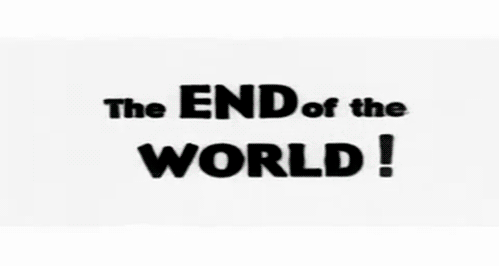
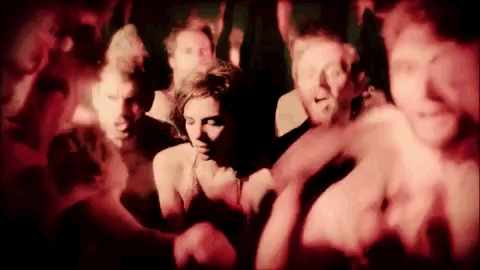









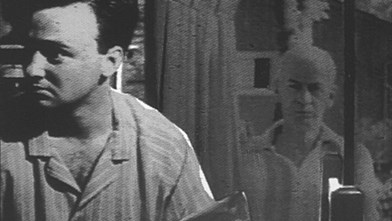
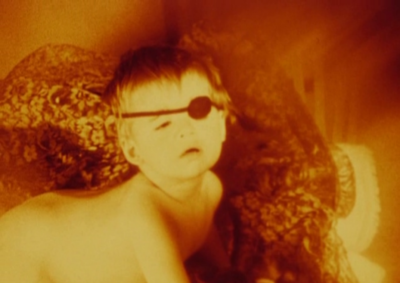

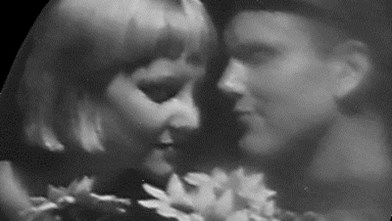




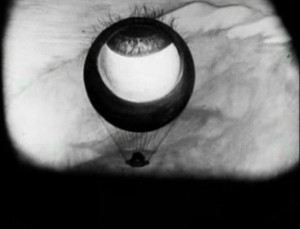
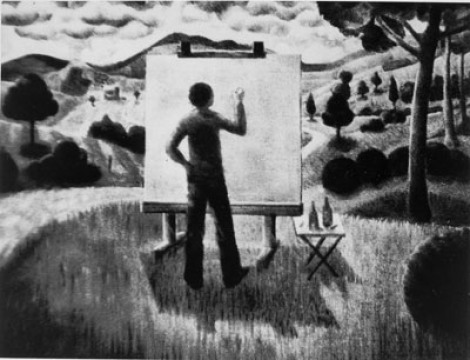

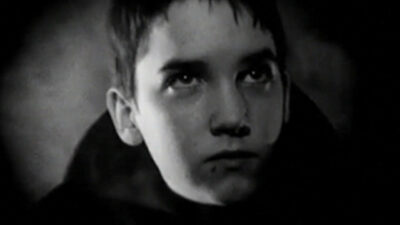
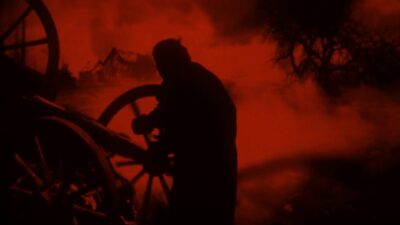
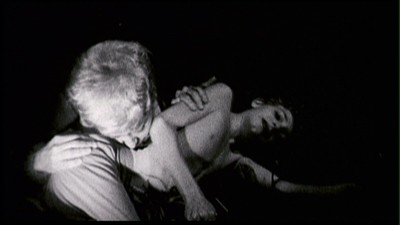

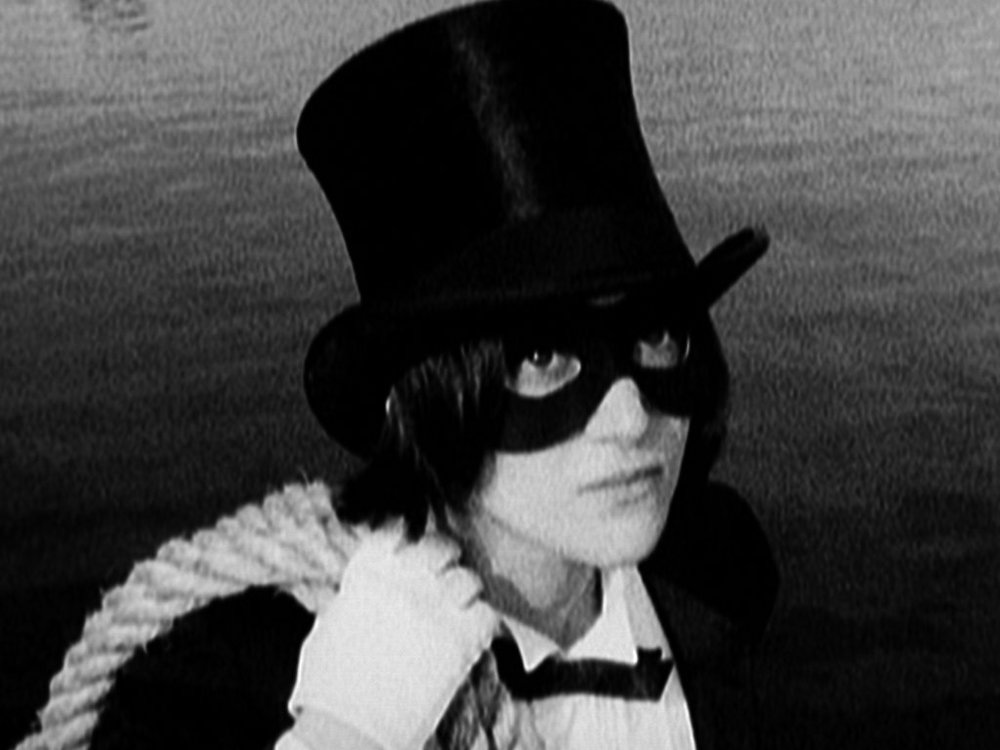
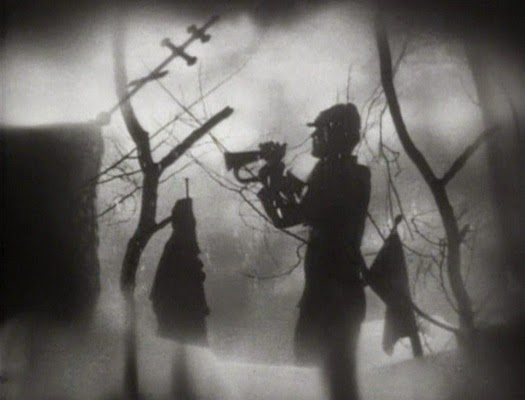
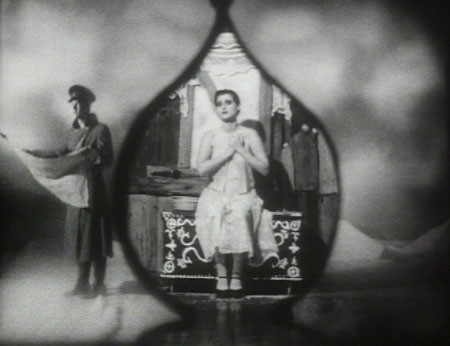
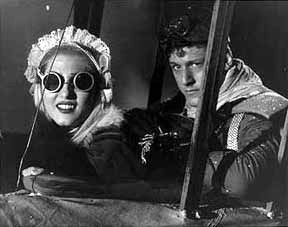
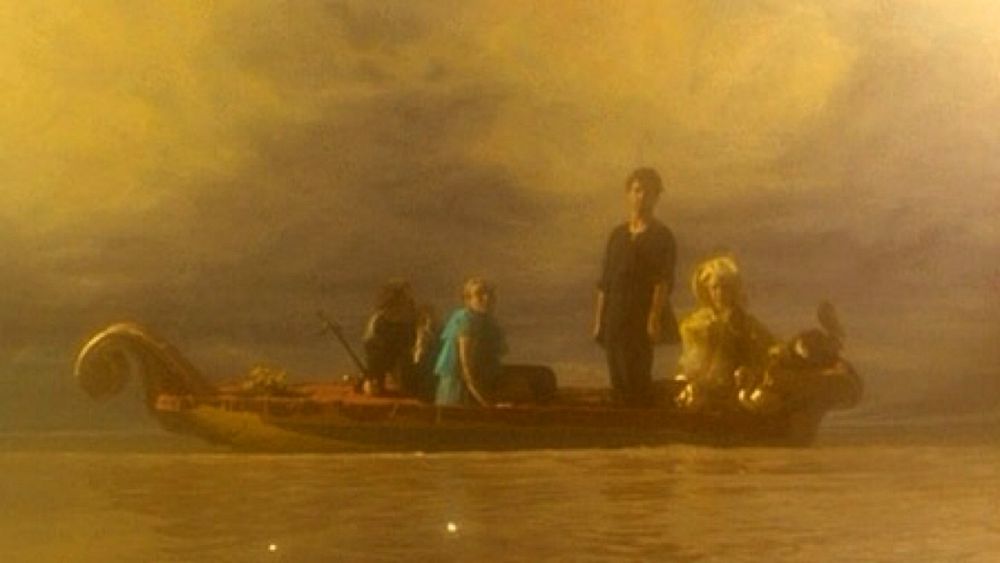
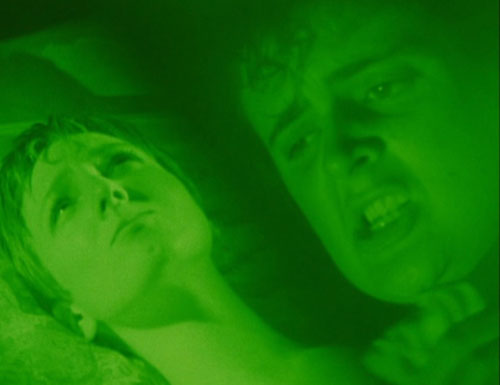
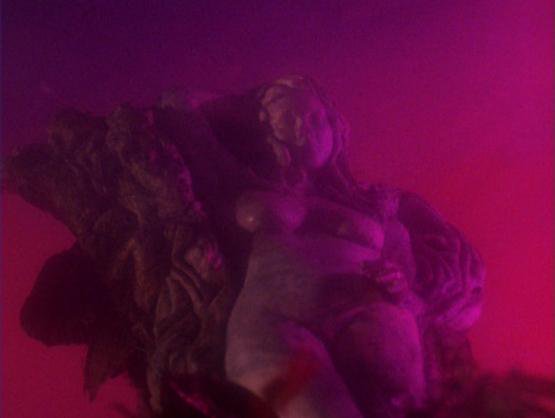
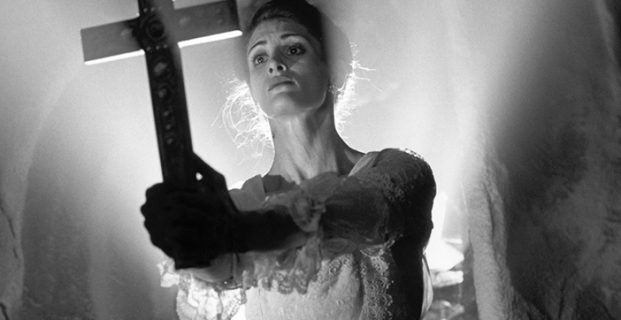
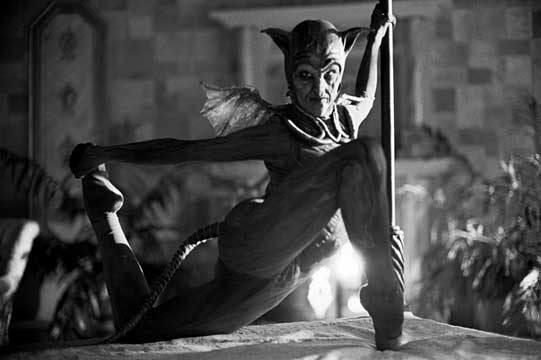
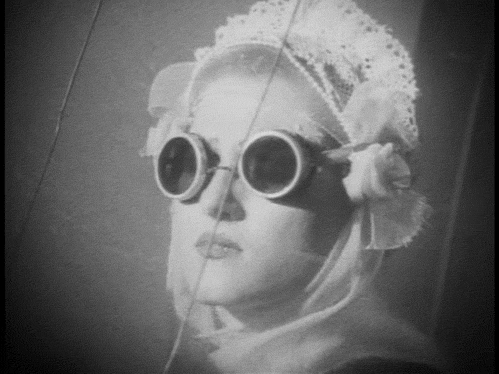


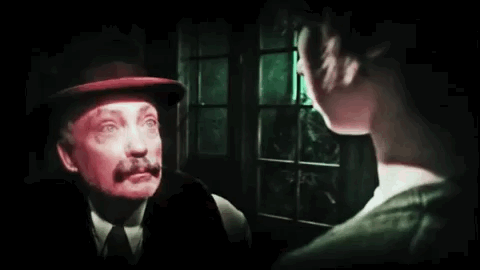


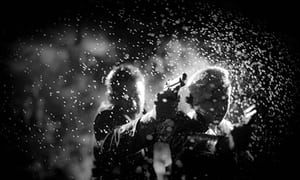
















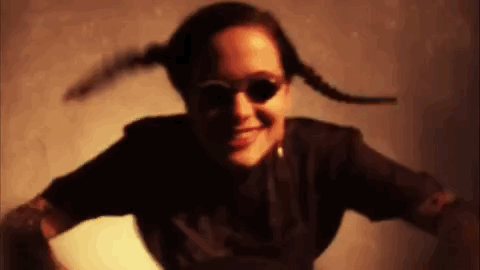



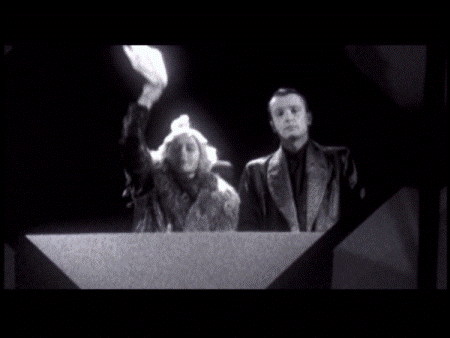








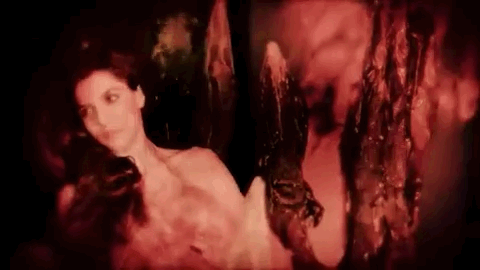


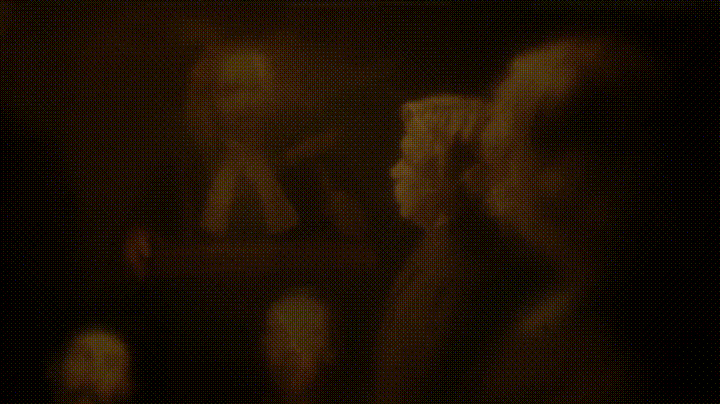

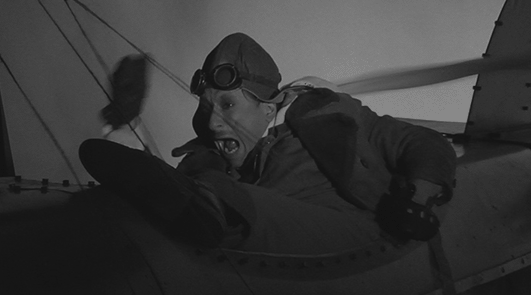


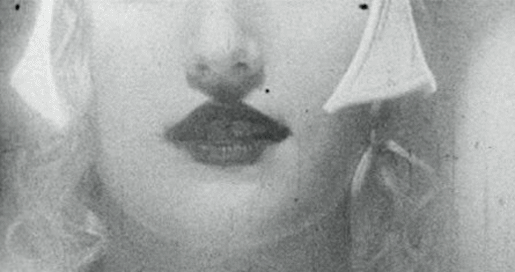
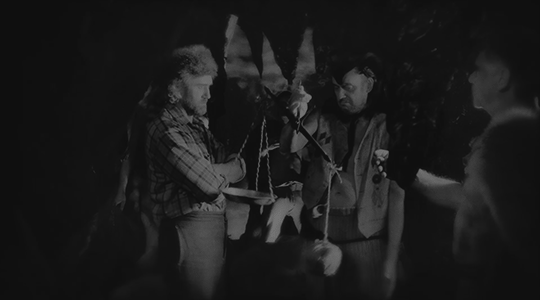

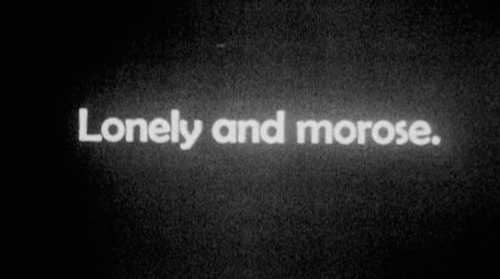






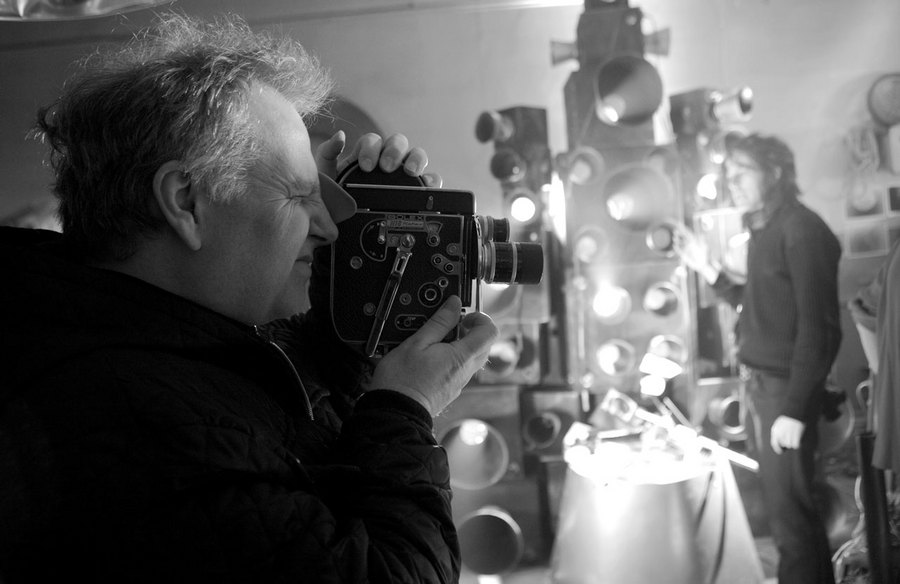
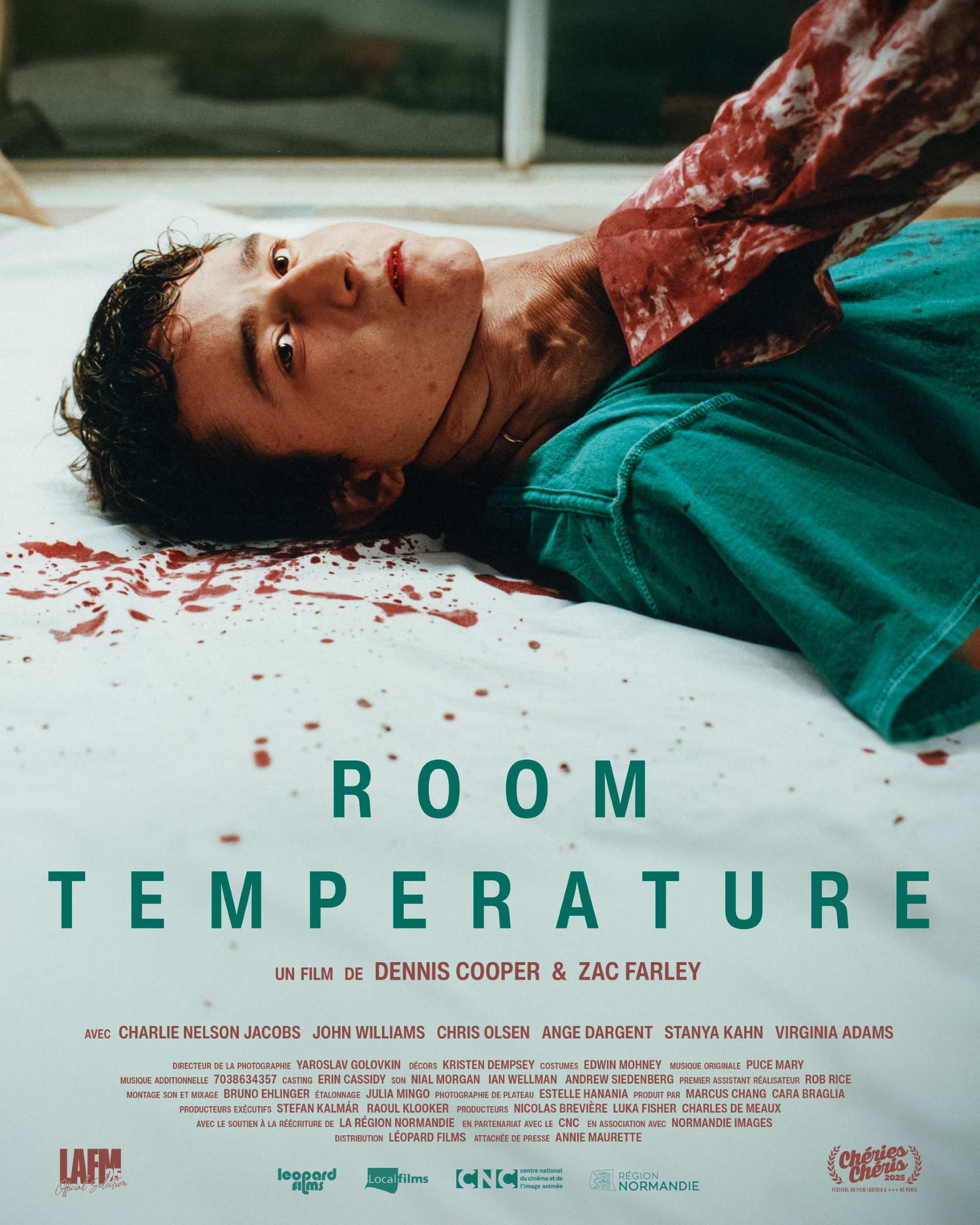



 Now available in North America
Now available in North America 